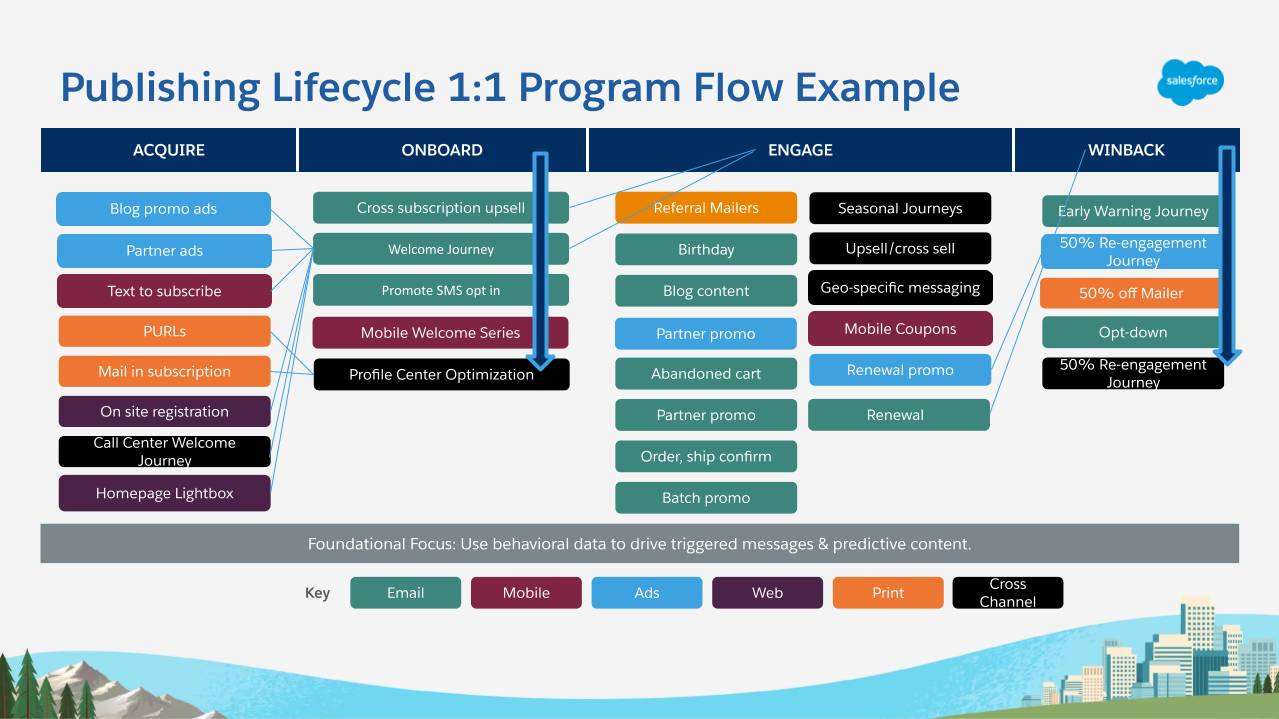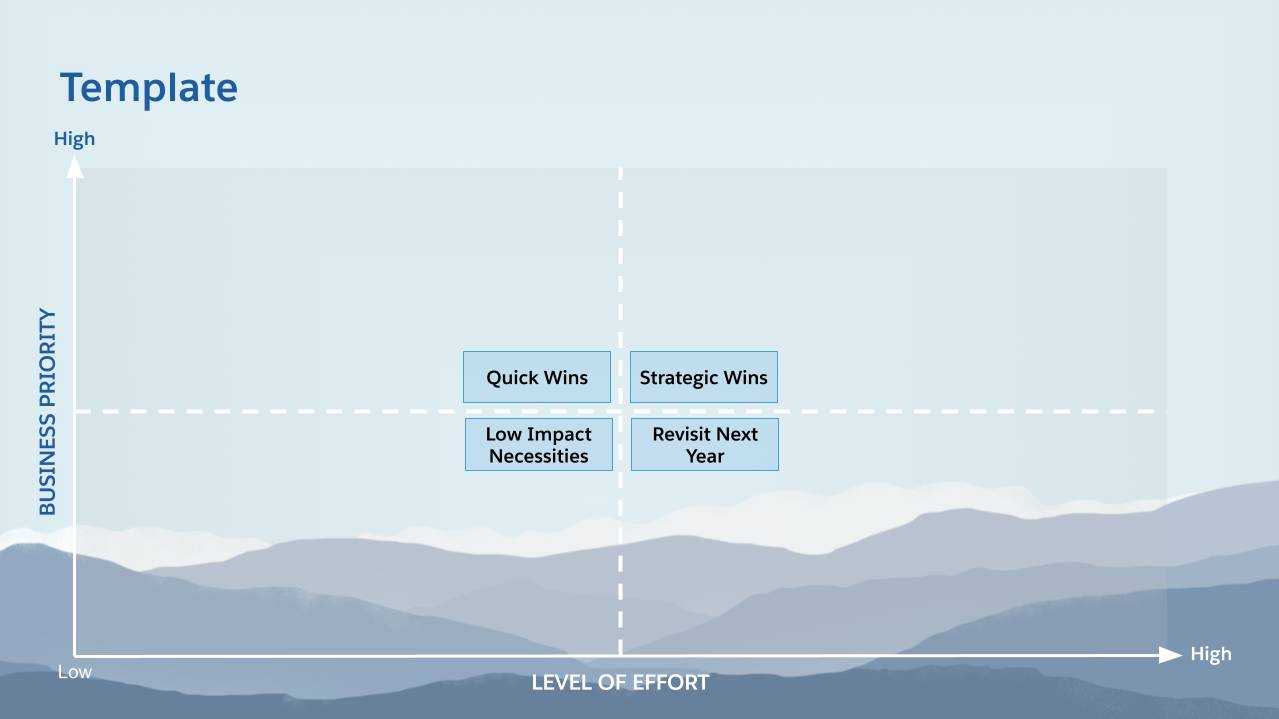Prioritize Your Journeys
Learning Objectives
After completing this unit, you’ll be able to:
- Outline your customer experience.
- Identify gaps in your plan.
- Prioritize journeys based on your goals.
The Big Picture
Marketers spend so much time perfecting each customer experience that it can be hard to find time to focus on the bigger picture. Every customer journey links back to a larger goal, which is ultimately the success of your business. But how do you bridge the gap between where you are now and where you want to be? And how do you make sure your customers follow you on the path to success? This module helps you define your customer’s experience, decide which journeys best fit that experience, and guide them into those journeys.
No matter what business you’re in, you want to provide the best possible customer experience. And it’s no different for some of our favorite fictional brands on Trailhead. Cloud Kicks wants its customers to go from seeing the perfect shoe in store or online to feeling comfortable and active in their new purchase. Northern Trail Outfitters strives to give its customers the most comfortable outdoor wear and trustworthy camping equipment around. DreamHouse Realty plans all of its efforts around matching clients with the right properties, providing the smoothest, trouble-free experience. All of these goals require careful planning and decisions on competing priorities. So, let’s walk through the process to craft your own long-term vision and make some concrete decisions.
- Figure out where you interact with your customers.
- Finalize and write out your long-term vision for your business.
- Support that vision with concrete goals for the fiscal year.
- Prioritize the journeys that support those goals.
- Track contact activities and behaviors to steer them into prioritized journeys.
Customer Touchpoints
We already mentioned the importance of a good customer experience—and while it is key to consider what you want your customers to experience, you also need to objectively assess what your customers actually experience right now. Start from the very beginning, when your customer first encounters your brand, and map out all the possible interactions and touchpoints that you might need to reimagine. You already know the beginning and the end—you’re just filling in the steps in between.
Long-Term Vision
You know the goal for your customer, but what’s the goal for your brand? Where do your strategy and efforts lead your company? This goes beyond the typical “Where do you see yourself in 5 years?” and instead asks you to consider your brand’s place in the larger business ecosystem. What concepts and values does your brand address, and how do you remain true to them? Remember that this isn’t a one-time assessment, either. You should leave some space in the process for reevaluation due to shifting trends and circumstances.
Fiscal Year Goals
After you lay out the long-term vision, you can break down your efforts into smaller chunks. Sure, a fiscal year may seem like a big chunk, but not when you think about the overall story arc you just laid out. Think of it as the string of blockbusters in your cinematic universe (which is especially applicable if you’re actually making movies). Figure out what you need to do this fiscal year, both for your overall goals and your team specifically.
This goal-setting exercise showcases how important it is to work closely with other teams inside your company. That doesn’t mean that everybody should be in the room when you’re making decisions, but you need input and feedback from all the applicable teams. Once you’ve gathered that information, designate a leader to start setting goals and taking action. Remember that you can start this process with a single journey or a single goal, and then iterate from there. The journey always begins with the first step. You already know where you are and where you’re going. So, you’re simply setting your milestones.
Create Your Strategic Plan
Let’s follow an example from Northern Trail Outfitters (NTO). The NTO team structures their strategic plan around their customer lifecycle—which includes acquiring, onboarding, engaging, and winning back customers. The following lifecycle example represents a full fiscal year of NTO’s plans, so this work wouldn’t be completed at the same time or even by a single team. But it gives you an idea of the scope of your strategy planning.

It helps to break down this lifecycle strategy into more manageable tasks. For example, NTO plans to focus on how the email welcome journey can onboard new subscribers and encourage SMS subscriptions. How did the welcome journey become a priority during NTO’s fiscal year planning? Lots of factors help the team decide what’s going to accomplish the most good with the available resources. Consider these topics as you conduct your own strategy sessions for your fiscal year planning.
- Time sensitivity of the project
- Largest conversion amount (in currency)
- Departments and stakeholders involved
- Value to the customer
- Overall business goals
- ROI and profitability of email
- Member engagement and preference
- Historical email performance
After considering these factors, the NTO team decided to focus on making an impact through their email journeys. Email journeys still encompass a broad category of work, so the team broke it down further by the types of emails they send.
| Email Type | Description |
|---|---|
|
Transactional |
Behavioral triggers, confirmations, recalls, and other must-send communications |
|
Events |
Webinars and time-sensitive activities |
|
Newsletters |
News and updates |
|
Welcome |
Onboarding campaigns |
|
Nurture |
Lifecycle campaigns |
Now the NTO team needs to decide which email journeys get prioritized. To do this, the team coordinates using a template that allows them to plot both the level of effort and business priority.

Now that NTO knows which messages are targeted to give them the best results, they can focus on prioritizing the journeys powering those messages. They also want to make sure high-value contacts get into those journeys. We’ll take a look at how to do that in the next unit.